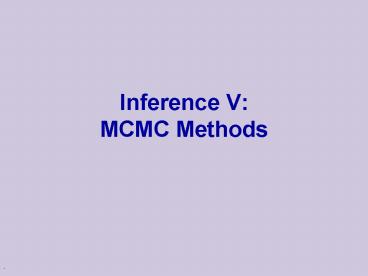Inference V: MCMC Methods PowerPoint PPT Presentation
1 / 21
Title: Inference V: MCMC Methods
1
Inference VMCMC Methods
2
Stochastic Sampling
- In previous class, we examined methods that use
independent samples to estimate P(X x e ) - Problem It is difficult to sample from P(X1, .
Xn e ) - We had to use likelihood weighting to reweigh our
samples - This introduced bias in estimation
- In some case, such as when the evidence is on
leaves, these methods are inefficient
3
MCMC Methods
- We are going to discuss sampling methods that are
based on Markov Chain - Markov Chain Monte Carlo (MCMC) methods
- Key ideas
- Sampling process as a Markov Chain
- Next sample depends on the previous one
- These will approximate any posterior distribution
- We start by reviewing key ideas from the theory
of Markov chains
4
Markov Chains
- Suppose X1, X2, take some set of values
- wlog. These values are 1, 2, ...
- A Markov chain is a process that corresponds to
the network - To quantify the chain, we need to specify
- Initial probability P(X1)
- Transition probability P(Xt1Xt)
- A Markov chain has stationary transition
probability - P(Xt1Xt) is the same for all times t
5
Irreducible Chains
- A state j is accessible from state i if there is
an n such that P(Xn j X1 i) gt 0 - There is a positive probability of reaching j
from i after some number steps - A chain is irreducible if every state is
accessible from every state
6
Ergodic Chains
- A state is positively recurrent if there is a
finite expected time to get back to state i after
being in state i - If X has finite number of states, then this is
suffices that i is accessible from itself - A chain is ergodic if it is irreducible and every
state is positively recurrent
7
(A)periodic Chains
- A state i is periodic if there is an integer d
such thatP(Xn i X1 i ) 0 when n is not
divisible by d - A chain is aperiodic if it contains no periodic
state
8
Stationary Probabilities
- Thm
- If a chain is ergodic and aperiodic, then the
limitexists, and does not depend on i - Moreover, letthen, P(X) is the unique
probability satisfying
9
Stationary Probabilities
- The probability P(X) is the stationary
probability of the process - Regardless of the starting point, the process
will converge to this probability - The rate of convergence depends on properties of
the transition probability
10
Sampling from the stationary probability
- This theory suggests how to sample from the
stationary probability - Set X1 i, for some random/arbitrary i
- For t 1, 2, , n
- Sample a value xt1 for Xt1 from P(Xt1Xtxt)
- return xn
- If n is large enough, then this is a sample from
P(X)
11
Designing Markov Chains
- How do we construct the right chain to sample
from? - Ensuring aperiodicity and irreducibility is
usually easy - Problem is ensuring the desired stationary
probability
12
Designing Markov Chains
- Key tool
- If the transition probability satisfiesthen,
P(X) Q(X) - This gives a local criteria for checking that the
chain will have the right stationary distribution
13
MCMC Methods
- We can use these results to sample from
P(X1,,Xne) - Idea
- Construct an ergodic aperiodic Markov Chain
such that P(X1,,Xn) P(X1,,Xne) - Simulate the chain n steps to get a sample
14
MCMC Methods
- Notes
- The Markov chain variable Y takes as value
assignments to all variables that are consistent
evidence - For simplicity, we will denote such a state using
the vector of variables
15
Gibbs Sampler
- One of the simplest MCMC method
- At each transition change the state of just on Xi
- We can describe the transition probability as a
stochastic procedure - Input a state x1,,xn
- Choose i at random (using uniform probability)
- Sample xi from P(Xix1, , xi-1, xi1 ,, xn,
e) - let xj xj for all j ? i
- return x1,,xn
16
Correctness of Gibbs Sampler
- By chain rule
- P(x1, , xi-1, xi, xi1 ,, xne) P(x1, ,
xi-1, xi1 ,, xne)P(xix1, , xi-1, xi1 ,,
xn, e) - Thus, we get
- Since we choose i from the same distribution at
each stage, this procedure satisfies the ratio
criteria
17
Gibbs Sampling for Bayesian Network
- Why is the Gibbs sampler easy in BNs?
- Recall that the Markov blanket of a variable
separates it from the other variables in the
network - P(Xi X1,,Xi-1,Xi1,,Xn) P(Xi Mbi )
- This property allows us to use local computations
to perform sampling in each transition
18
Gibbs Sampling in Bayesian Networks
- How do we evaluate P(Xi x1,,xi-1,xi1,,xn) ?
- Let Y1, , Yk be the children of Xi
- By definition of Mbi, the parents of Yj are in
Mbi?Xi - It is easy to show that
19
Sampling Strategy
- How do we collect the samples?
- Strategy I
- Run the chain M times, each run for N steps
- each run starts from a different state points
- Return the last state in each run
M chains
20
Sampling Strategy
- Strategy II
- Run one chain for a long time
- After some burn in period, sample points every
some fixed number of steps
burn in
M samples from one chain
21
Comparing Strategies
- Strategy I
- Better chance of covering the space of
pointsespecially if the chain is slow to reach
stationarity - Have to perform burn in steps for each chain
- Strategy II
- Perform burn in only once
- Samples might be correlated (although only
weakly) - Hybrid strategy
- run several chains, and sample few samples from
each - Combines benefits of both strategies

